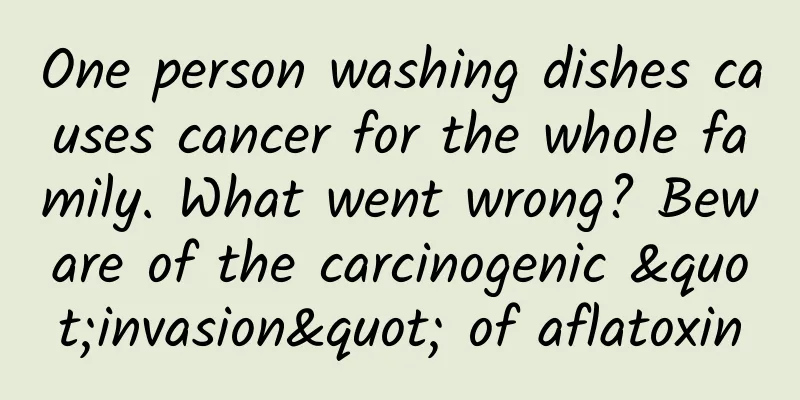One person washing dishes causes cancer for the whole family. What went wrong? Beware of the carcinogenic "invasion" of aflatoxin

|
It is not uncommon to hear news reports of excessive levels of aflatoxin on tableware at home due to improper dishwashing habits. Recently, another family was poisoned by this, and one family member was even diagnosed with liver cancer. Such incidents highlight the serious threat of aflatoxin to human health and remind us that even daily household chores may hide health risks. Below, we will explore the sources of aflatoxin, its impact on human health, and how to prevent this invisible killer in life. What are aflatoxins? Aflatoxins are a type of secondary metabolites produced by Aspergillus flavus and Aspergillus parasiticus. More than 20 types of aflatoxins have been discovered, among which aflatoxin B1 is the most toxic and carcinogenic. Studies have shown that aflatoxin B1 is extremely toxic to the liver. Even a very small dose can cause serious liver damage, and long-term exposure may induce liver cancer. Aspergillus flavus and Aspergillus parasiticus are widely found in nature, especially in warm and humid environments, which provide an ideal place for their growth and reproduction. These two fungi can infect a variety of food crops, such as corn, rice, wheat, peanuts, etc., as well as nuts, such as walnuts, almonds, cashews, etc. When these foods encounter suitable temperature and humidity during storage and transportation, Aspergillus flavus and Aspergillus parasiticus will grow and reproduce, and produce aflatoxins. In addition, aflatoxins can also be produced in animal feed, affecting human health through the food chain. The relationship between aflatoxin and dishwashing People are mainly exposed to aflatoxin by eating food contaminated with it. In developing countries, aflatoxin contamination is a more serious problem due to limited food storage and processing conditions. Improper dishwashing habits, such as using contaminated dishcloths, not washing dishes in time, or storing dishes in a humid environment, may promote the growth of aflatoxin on tableware. Long-term use of these dishes that have not been thoroughly cleaned may cause people to ingest aflatoxin through the mouth, thereby increasing the risk of cancer. The harm of aflatoxin 1. Aspergillosis Aspergillosis is a lung infection caused by Aspergillus fungi, which mainly affects people with weakened immune systems. Aflatoxin is one of the key factors causing aspergillosis. About 48,000 people worldwide suffer from allergic bronchopulmonary aspergillosis, of which 4,000 also suffer from chronic pulmonary aspergillosis. In addition, 12,000 tuberculosis patients also suffer from chronic pulmonary aspergillosis. 2. Aflatoxin poisoning Aflatoxin poisoning can be divided into acute poisoning and chronic poisoning. Acute poisoning is mainly manifested by fever, vomiting, ascites, liver failure and other symptoms, with a high mortality rate. Chronic poisoning is manifested by liver damage, growth retardation, decreased immunity, etc., and may induce serious diseases such as hepatocellular carcinoma and cirrhosis. 3. Cancer Aflatoxin has been classified as a Class I carcinogen by the World Health Organization's Cancer Research Institute. Long-term exposure to aflatoxin can cause cancer in organs such as the liver, kidneys, lungs and colon. Relevant research data show that 4.6% to 28.2% of hepatocellular carcinomas worldwide are related to aflatoxin intake. Aflatoxin prevention measures 1. Strengthen food storage and management During the storage of grain, the temperature and humidity must be strictly controlled to prevent the growth of aflatoxin. In addition, grain should be tested regularly and any aflatoxin exceeding the standard should be dealt with in a timely manner. 2. Food processing and cooking During food processing and cooking, aflatoxin-contaminated parts should be removed as much as possible. For example, nuts should be shelled before consumption, and grains such as corn and rice should be thoroughly washed. 3. Develop good dishwashing habits Make sure to use clean dishcloths and detergent to wash dishes thoroughly, especially those containers used to store grains and nuts. Avoid storing dishes in a humid environment to reduce the growth of aflatoxin. At the same time, dishwashing supplies such as dishcloths and sponges should be replaced regularly to prevent the growth of bacteria and mold. 4. Improve Immunity Maintaining good living habits, exercising regularly and enhancing immunity can help reduce the harm of aflatoxin. Relevant studies have mentioned that individuals with stronger immunity are more resistant to aflatoxin. References: Shabeer, S. Aflatoxin contamination, its impact and management strategies: An updated review[J]. Toxins, 2022, 14(5): 307. |
<<: Don't miss it! Mercury's last "gorgeous appearance" in 2024 is tomorrow →
>>: The outstanding appearance of corals is largely due to these “green pearls”!
Recommend
Strange radio signals coming from the center of the Milky Way, are they sent by aliens? The truth is…
People's curiosity about aliens has never cea...
This ocean "eater" is even crazier than sharks changing their teeth?
In the world of marine life, sharks are often kno...
Channel promotion: How to choose high-quality and suitable APP promotion channels
In the operation and promotion of APP, learning t...
How much does it cost to develop a mini program?
The editor still says the same things as before. ...
Tao Ge's "Love Map" improves love thinking and chat skills
Training course content: The course covers the at...
Typhoon "Little Dog" + cold air, be careful on your return trip!
As the holiday draws to a close, precipitation in...
Why did such an ordinary little sand pit cause him to fall and die?
Perhaps you often see these small pits in the san...
5 people were infected in 2 days! Doctors urgently remind you: Don’t do these things during the Spring Festival!
During the Spring Festival, in order to create a ...
Microsoft optimizes Teams Shifts app to send shift notifications to designated employees
On August 8, Microsoft officially released a blog...
Samsung S5's powerful fingerprint function sharing
Samsung's new flagship GALAXY S5 has brought g...
WordPress video tutorial course on building a foreign trade website from scratch
WordPress video tutorial course on building a for...
Behind the popularity of Xiaohongshu, how is the community operated?
Half a month ago, Xiaohongshu announced the compl...
【Clown Tutorial】The Road to Redshift Cultivation
[Clown Tutorial] Redshift Cultivation Path Resour...
Super practical dry goods: the universal formula for quickly creating good copywriting
When I was in college, my major was Chinese Langu...
I’m not kidding you, “mushroom skin” can actually be used to make bags!
Produced by: Science Popularization China Author:...









